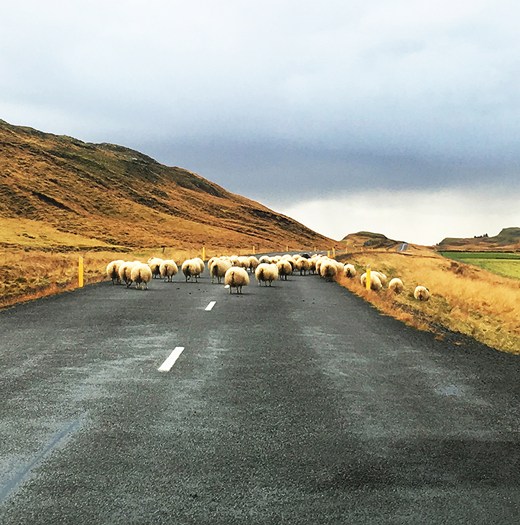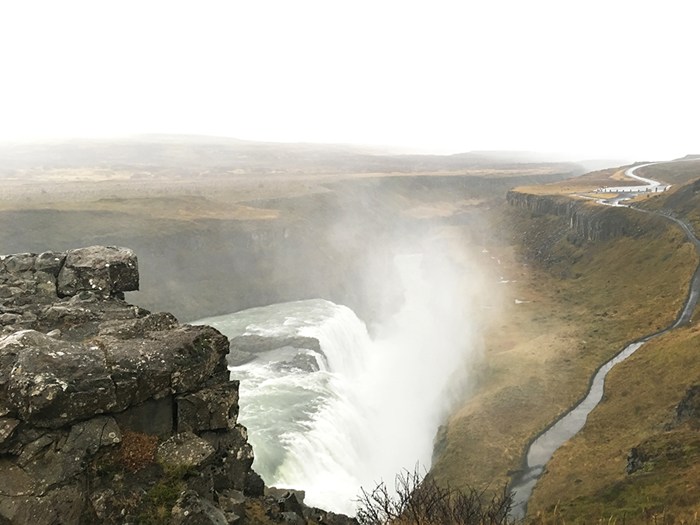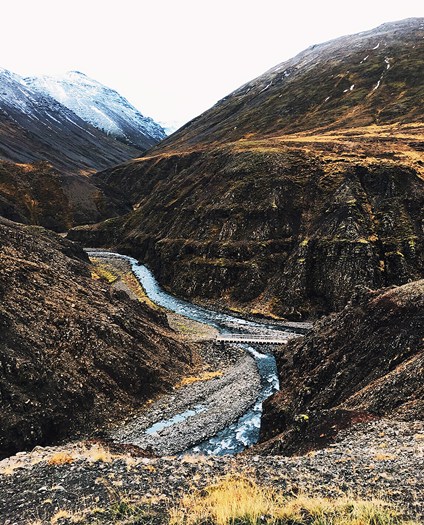AKUREYRI, ICELAND - The scene opens with a beautiful landscape: hills, valleys and a lone car racing along a winding road above steep cliffs. This is something we’ve all seen in high-end car commercials, but if you visit Iceland, it is something you can experience for yourself.
“If we had been going any faster we would have fallen off the edge,” I said to my partner after a series of sharp turns on the Víkurskarð road, just east of here. The speed limit lowers to 70 km/h around the sharpest bends, which sit atop a very steep drop to the valley. And there isn’t even a guardrail.
The country’s Iceland Airwaves music festival is what brought us to the island, famous for intrinsically designed wool sweaters, skyr and an awe-inducing landscape of mountains, volcanoes, waterfalls, ocean and greenery. We had four days to explore as much of the country as possible and knew the best way to do it was by road.
Iceland’s rental car agencies offer you an option of SUVs that can be driven on their most rugged roads, known as F-roads. I like to pretend the ‘F’ stands for forbidden but it’s actually for fjallvegir, the Icelandic word for mountain.

Above: A traffic jam in Iceland.
Advanced adventure seekers are encouraged to take on that option, as it gives you the opportunity to drive through the island’s highlands, see unbelievable views and get as close to the volcano and mountains as safely possible. For moderate adventurers, like myself, don’t worry. Everywhere you look in Iceland is an incredible, and Instagram-worthy, view — and there are plenty heart-pounding, steering wheel-gripping sections on the main road.
If you want the full experience of seeing the island, it’s best to look into the cozy accommodations offered along the way. There are many different hotels, cabins and B&Bs available in most towns. We opted to stay planted in Reykjavik and set out southeast, north and southwest each day.
Southeast: Iceland’s scenic route
Iceland’s Ring Road, Highway 1, highlights the country’s most famous attractions while circling the island. We set out early in the morning towards the sunrise, which beautifully crept up over the mountaintops in the distance — even through the on-again, off-again rain.
First stop, Geysir. The smell of sulphur, distinctly similar to boiled eggs, overwhelms you while visiting Iceland’s thermal areas, but becomes oddly comforting by the time you’re set to go home. The area surrounding Geysir is clouded in that smell. This 10,000-year-old monster has the power to spout boiling water up to 70 metres in the air. However, its activity has been very infrequent for the past 80 years. This might have you wondering why you’re there in the first place, but it won’t be long before an eruption of water 15 metres high reminds you. That’s Strokkur. And although it’s not as powerful as the great Geysir once was, it’s incredible to see Mother Nature put on a show. Stokkur erupts once every 10 minutes, so if you stick around you’ll see a couple great spurts.
Not far from Geysir is Gullfoss, Icelandic for Golden Falls. This 32-metre-high waterfall is separated into two drops, creating double the echo of water crashing into water. You have the opportunity to view the falls from the picturesque top and from ground level, where you can almost touch the water as it gushes past you at 140-square-metres per second.

Above: Iceland is a land of breathtaking natural wonders.
The next leg of our drive was a flat one, but the furthest thing from boring. The meadows are very colourful and filled with animals. And, as we discovered, sometimes those animals will join you on the road.
“What do I do?” my partner asks, as we found ourselves riding through a flock of sheep on a small two-lane highway.
“Drive around them, I guess. Slowly.”
There was no way around the animals and each time we inched forward they would become scared and run ahead. Their thin legs carried their fluffy bouncing bodies in a sprint for about a kilometre before we were able to break free. Our apologies to the farmer who had to fetch them later.
Everything East of Selfoss is a series of small and large rolling hills. On one side, the Atlantic Ocean, vast and shimmering; on the other, towering black mountains and hills sprinkled with a series of waterfalls.
We took a stop in Vík, known to be the rainiest spot in Iceland, to stare in awe at the famous black sand beach. White-capped waves roll in and crash against the black ashy beach every few seconds, and with the rainy grey sky in the background, what looks like a gorgeous black and white photograph is created.
The farthest east we drove was Skaftafell, known as the Southern entrance to Vatnajökull National Park, home of the Vatnajökull glacier, which covers 8 per cent of the country. It is massive. At sunset, this enormous giant, covered in snow and ice, blocks all light hours before the sun passes below the horizon.
This made driving back to Reykjavik interesting, as we were literally chasing the sunset, catching it in flashes as the glaciers, mountains and hills decreased in size.
North: Adventure seekers apply here
North Iceland is where the real adventurous driving takes place.
After heading through the 5,770-metre Hvalfjörður Tunnel, it was straight north to Akureyri — though the road is anything but straight. The entire trip requires you to truly trust the grip of your tires, especially if there is snow, as you climb straight up one side of a gigantic hill and roll right down the other.
With the rollercoaster-like roads come incredible views, the kind that make you say “wow” out loud after every hurdle. These are the kinds of views that make you feel like you’re wandering through Middle Earth. Snow-covered mountaintops. Mossy cliffs. Green valleys. Bright blue skies. And nobody else in sight. Take time to pull over, admire the view and breathe in some of the freshest clean air you’ve ever breathed.

Above: Around every bend in the road, an awesome scene awiats.
Turning east past Akureyri, the road gets smaller and the hills get steeper. Each turn is sharp and overlooks a rigid long way down. The speed limit around most of Iceland is 90 km/h, but around here it lowers to 70. Once your heart settles you’ll reach your reward destination, that magnificent and grand Goðafoss, waterfall of the gods. The 12-metre drop stretches across 30 metres of land, surrounded by shiny brown rocks and green grass. It’s relaxing atmosphere and position makes it the perfect place to watch the sun set.
Our drive back to Reykjavik was heightened in intensity with a combination of darkness and snow lining the roads, neither of which had been there on the way up. We took it slow, avoiding any possible ice, and took in a few moments to stop on the side of the road, get out of the car, and appreciate the Northern Lights dancing above us.
Southwest: The road less travelled
Most people travelling west from Reykjavik are heading to the Keflavík International Airport or the gorgeous Blue Lagoon. While it’s important to take a dip in Iceland’s famous thermal bath, named one of the 25 wonders of the world, and experience the relaxing salty water, there are other attractions just beyond the road.
A coastal road brought us to the bird cliffs, where we hiked through sand and rocks for an hour to reach the Atlantic Ocean, crashing against the walls of rock and bringing in strange items from passing ships.
Rounding past the lighthouse at the most southwestern part of the Reykjanes peninsula, you begin to drive through the 100 Craters Park, a series of brown winding roads. What you’re driving through is volcanic zones and hundreds of open fissures, with varying levels of activity.
We stopped in Grindavík for lunch at a hidden gem, buried between warehouses on Miðgarði street. Bryggjan offers the best homemade lobster soup, or lamb soup if you’d prefer, with a generous portion and includes warm bread and butter and a beverage. The buttery soup and phenomenal harbour view makes the perfect stop for a weary traveller.
Heading back north, chasing a rainbow through volatile, sulphur-laden land, not only could we see the entire arch, but the end of the rainbow was visible — as in, the part of the rainbow where there should be a pot of gold. There was no pot of gold, but our beautiful drive took us to our final adventure stop — Seltún.
The boiling geothermal area of mud pots and hot springs has created a colourful palette in the surrounding soil. You can hike through the area and climb to the top of the hill, where you can look out as far as the ocean.
While Iceland does attract many tourists, my partner and I were often either the only people, or two of a handful of people, at each attraction. Even driving on the main highway there was rarely anybody else on the road. It made us feel like we were truly free to explore and feel welcome. We will definitely visit again — maybe next time renting an SUV and tackling the centre of the island.
Information
Some rules of the road in Iceland: If no signs are in view, the general speed limit is 50 km/h while driving through a town, 80 km/h on gravel and 90 km/h on the main paved roads. / You’ll often come across single-lane bridges, with traffic flowing from both directions. The general rule is for the car that was closer to the bridge to cross while the opposite car yields. / To rent a car in Iceland you must be 25 or older. / Always check weather and road conditions before you travel, otherwise you may hit a dead end at a closed road. Getting there: Icelandair offers direct flights from Toronto, Halifax, Vancouver and Edmonton to Reykjavik. The flight from Toronto is five hours.